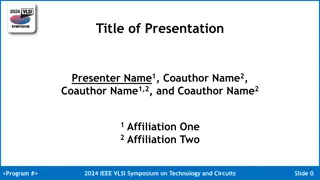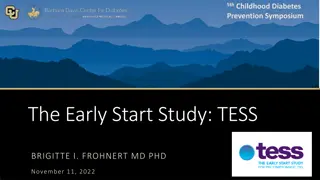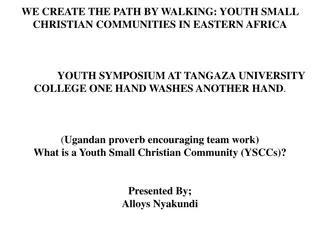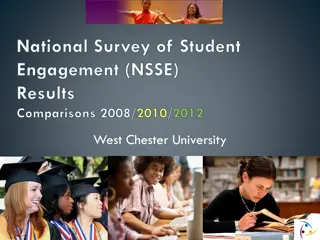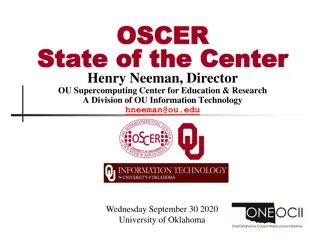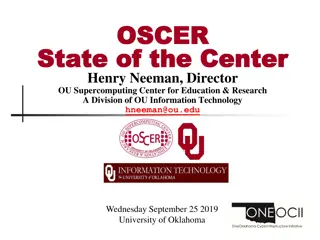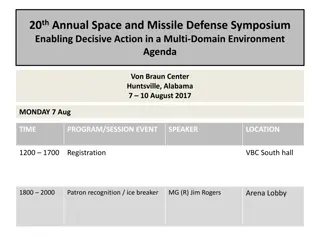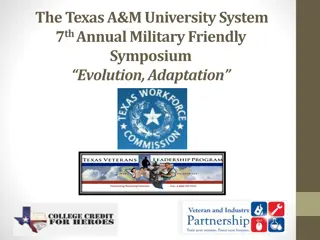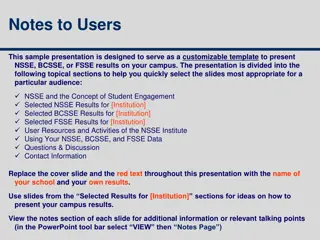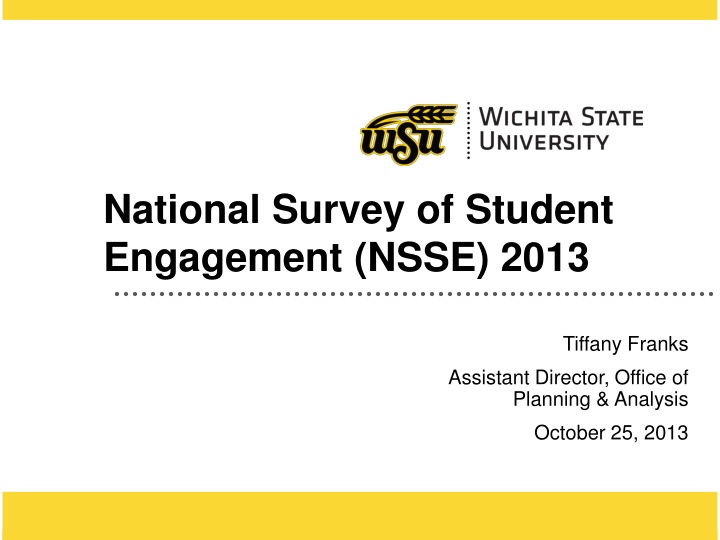
Student Engagement at WSU through NSSE 2013 Data
Explore the findings from the National Survey of Student Engagement (NSSE) conducted in 2013 at Washington State University (WSU), focusing on student participation rates, demographics, and areas for improvement in the undergraduate experience. Discover insights into first-year students' and seniors' engagement, response rates, and race/ethnicity breakdowns.
Download Presentation

Please find below an Image/Link to download the presentation.
The content on the website is provided AS IS for your information and personal use only. It may not be sold, licensed, or shared on other websites without obtaining consent from the author. If you encounter any issues during the download, it is possible that the publisher has removed the file from their server.
You are allowed to download the files provided on this website for personal or commercial use, subject to the condition that they are used lawfully. All files are the property of their respective owners.
The content on the website is provided AS IS for your information and personal use only. It may not be sold, licensed, or shared on other websites without obtaining consent from the author.
E N D
Presentation Transcript
National Survey of Student Engagement (NSSE) 2013 Tiffany Franks Assistant Director, Office of Planning & Analysis October 25, 2013 1
NSSE 2013WSU Participation What is NSSE? Annual survey that collects data about student participation in activities and programs that promote learning & personal development Results from NSSE can be used to identify aspects of the undergraduate experience that can be improved through changes in policies and practices NSSE is administered every other year (odd years) at WSU to first-year students and seniors, last administered in spring 2013
NSSE 2013WSU Participation For 2013, 1,254 and 3,305 email invitations to take NSSE were sent to first-year students and seniors, respectively Survey responses for first-year students totaled 262 (21%), and 842 for seniors (25%)
NSSE 2013 Participation 568 postsecondary institutions participated in NSSE 2013, with 335,702 students, 41% first- year students and 59% seniors Overall response rate was 30%, 27% for first- year students and 33% for seniors
NSSE 2013 WSU Participation cont. First-year respondents were 62% female and 92% were enrolled full-time Senior respondents were also 62% female, and 78% were enrolled full-time 100% 92% 90% 78% 80% 70% 62% 62% 60% Female 50% Full-Time 40% 30% 20% 10% 0% Senior Respondents FY Respondents
NSSE 2013 WSU Participation cont. Freshmen Race/Ethnicity WSU FY NSSE Participants *0%=American Indian & Native Hawaiian All NSSE Participants *Unknown race not included 3.0 2.00.0 1.0 1.0 Asian Asian 1.5 3.0 0.0 3.1 0.0 American Indian/Alaskan Native 9.9 American Indian/Alaskan Native 10.0 6.5 6.1 Black or African American Black or African American 10.0 Hispanic or Latino 11.1 Hispanic or Latino White White Native Hawaiian/other Pacific Islander Native Hawaiian/other Pacific Islander 70.0 61.8 Foreign or Nonresident alien Foreign or Nonresident alien Two or more races/ethnicities
NSSE 2013 WSU Participation cont. Seniors Race/Ethnicity WSU Senior NSSE Participants All NSSE Senior Respondents *unknown race not included American Indian/Alaskan Ntv 4.3% American Indian/Alaskan Ntv 1.0% 1.0 0.0 1.2% 2.0 Asian 4.5% Asian 3.0 6.4% 3.0 Black or African American 10.0 5.8% Black or African American 6.7% 0.5% Hispanic or Latino 10.0 Hispanic or Latino Native Hawaiian/Other Pacific Islander 1.0 Native Hawaiian/Other Pacific Islander White White Foreign or Nonresident alien 69.7% 70.0 Foreign or Nonresident alien Two or more races/ethnicities Two or more races/ethnicities Unknown
NSSE 2013 Participation Other demographics of all NSSE participants: 29% were 24 years or older 35% lived on campus 46% were first generation college students 34% began college at another institution other than where they took NSSE WSU Participants: 38.2 were 24 years or older 6% lived on campus 43% were first generation college students 46% began college at another institution other than where they took NSSE
Changes to NSSE 2013 NSSE updated and revised the survey for 2013; 23% are new items, 22% were left unchanged, and 50% were modified, either a major or minor modification Minor 28% New 23% New No Change Major Modification Minor Modification No Change22% Major 27%
Changes to NSSE 2013 Instead of using benchmarks , NSSE is now using Engagement Indicators and Measures of Participation in High Impact Practices Longitudinal comparisons of individual questions & historical benchmarks are somewhat limited due to different scoring metrics and deletion of some survey items
Changes to NSSE 2013 cont. There are 10 different engagement indicators which fall under one of four themes
NSSE Engagement Indicator Scoring Each Engagement Indicator is scored on a 60 point scale (never=0, sometimes=20, often=40, very often=60) Mean comparisons are given for each Engagement Indicator for WSU peer institutions (n=10), institutions with the same Carnegie Classification (Research University- High Research Activity, n=36) and all NSSE institutions (n=567)
WSU Peer Institutions Comparison peer institutions were selected by the President and the President s Executive Team and approved by the Kansas Board of Regents. WSU peer institutions are: Florida Atlantic University (Boca Raton, FL) Oakland University (Rochester Hills, MI) Portland State University (Portland, OR) University of Akron (Akron, OH) University of Arkansas at Little Rock (Little Rock, AR)
WSU Peer Institutions cont. WSU Peer Institutions continued: University of Colorado Denver (Denver, CO) University of Nebraska at Omaha (Omaha, NE) University of Nevada, Reno (Reno, NV) University of South Alabama (Mobile, AL) Western Michigan University (Kalamazoo, MI)
WSU Results and Peer Comparisons cont. Mean Comparisons of First-Year Students for questions relating to Academic Challenge
WSU Results and Peer Comparisons cont. Mean Comparisons of First-Year Students for questions relating to Learning With Peers
WSU Results and Peer Comparisons cont. Mean Comparisons of First-Year Students for questions relating to Experiences With Faculty
WSU Results and Peer Comparisons cont. Mean Comparisons of First-Year Students for questions relating to Campus Environment
WSU Results and Peer Comparisons cont. Mean Comparisons of Seniors for questions relating to Academic Challenge
WSU Results and Peer Comparisons cont. Mean Comparisons of Seniors for questions relating to Learning With Peers
WSU Results and Peer Comparisons cont. Mean Comparisons of Seniors for questions relating to Experiences With Faculty
WSU Results and Peer Comparisons cont. Mean Comparisons of Seniors for questions relating to Campus Environment
High Impact Practices High Impact Practices are activities with positive associations with student learning and retention, demand time and effort, facilitate learning outside of the classroom, require meaningful interactions with faculty and students, encourage collaboration with diverse others, and provide frequent and substantive feedback
High Impact Practices cont. NSSE founder George Kuh suggests all undergraduate students experience at least 2 High Impact Practices during their education Students were asked 6 questions regarding High Impact Practices (first-year students only asked questions 1-3) Seniors responses include their entire time at WSU, not just the current academic year
High Impact Practices cont.
High Impact Practices High Impact Practices at WSU
High Impact Practices at WSU First-Year Students
High Impact Practices at WSU First-Year Students
High Impact Practices at WSU Seniors
High Impact Practices at WSU Seniors
High Impact Practices at WSU Seniors
Perceived Gains Among Seniors Students reported how much their experience at WSU contributed to their knowledge, skills, and personal development in 10 areas: % Responding "Very much" or Quite a bit" % Responding "Very much" or Quite a bit" Being an informed and active citizen 48% Developing or clarifying a personal code of values & ethics 53% 53% Understanding people of other backgrounds Solving complex real-world problems 55% Analyzing numerical and statistical information 55% Speaking clearly & effectively 56% 57% Writing clearly & effectively Acquiring job or work-related knowledge and skills 64% Working effectively with others 66% Thinking crtitcallly & analytically 75% 0% 20% 40% 60% 80%
Satisfaction with WSU Students rated their overall experience at WSU and whether they would attend WSU again:
NSSE Caveats As with all surveys, NSSE also has some caveats: Survey is voluntary, which leads to lower response rates and may not be a representative sample of the student population Different methodologies used when selecting comparison groups (may not be selecting schools that would be appropriate for NSSE comparisons) Lack of awareness or interest in student engagement
Using NSSE Data NSSE data can be used in a variety of ways: Self-studies for accreditations Assessment & Improvement Faculty & Staff development Institutional Advancement State System Performance Reviews
Using NSSE Data at WSU NSSE is used at WSU in several ways: Results for specific questions posted on the Voluntary System of Accountability College Portrait (on WSU home page), all institutions participating in the College Portrait that use NSSE also report this data Performance Indicators for Kansas Board of Regents Foresight 2020
Using NSSE Data at WSU cont.
Using NSSE Data at WSU cont. Student Interaction with Campus Faculty and Staff 52.0% of seniors believed that the campus staff were helpful, considerate, or flexible 75.0% of seniors believed that faculty are available, helpful, or sympathetic 93.0% of seniors reported that faculty members provided prompt feedback on their academic performance 61.0% of seniors discussed readings or ideas with faculty members outside of class
Questions? Any questions? You may also email questions that may arise later to tiffany.franks@wichita.edu

